Rabdi, also called rabri, is a classic North Indian treat that’s rich, creamy, and perfectly sweet. To make rabri recipe, milk is cooked until it reduces to a thick pudding-like consistency, then is flavored with cardamoms, saffron, and your favorite nuts and dried fruits. Here you’ll find the best traditional rabdi recipe with step-by-step instructions and photos to prepare as a delicious dessert!
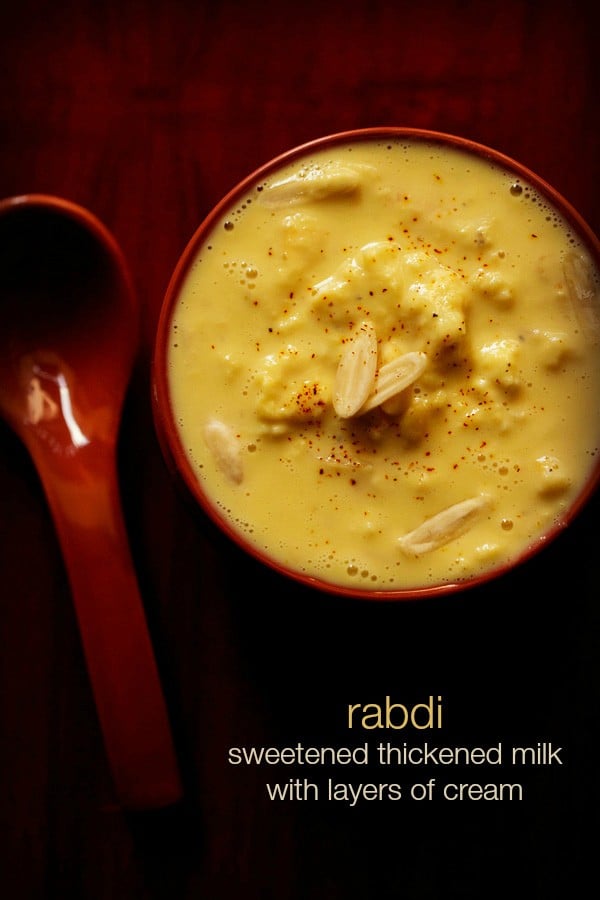
Table of Contents
About Rabdi Recipe
Traditional rabdi (called Lachha rabdi in Hindi) is a luscious dessert that’s often enjoyed for special occasions and holidays. And it’s easy to see why this treat deserves to be served at nearly every celebration!
Rabri features creamy layers of clotted cream (malai), crunchy nuts in a deliciously thick condensed milk. Each bite is a delightful combination of sweet flavors and textures that keeps you going in for another spoonful.
To make this rabri recipe does take a bit of time; however, the steps are quite simple. Start to finish you need a bit over an hour to prepare – but it is made in just one pot. Typically a kadai is used, as the broad shape helps the milk to cook and evaporate more quickly. But any thick-bottom deep pan with a larger surface area will do the trick!
Whole milk is simmered low and slow until it becomes a slightly-thick sweetened condensed milk, which is the base layer of the dish. As the milk cooks and cream forms on top, this cream is collected on the side of the pot to form layers of thicker clotted cream.
These malai layers are then added back into the condensed milk along with chopped nuts and delicate rose water to create distinct different textures.
The rabdi is served warm or chilled, either as dessert by itself or with other tasty sweet treats. Try this beloved classic rabri recipe for your next gathering, and be prepared for rave reviews!
What kind of pan to make Rabdi
A point to be noted is to use the right kind of pan when making sweets like rabdi. The milk is slow simmered which leads to water getting evaporated from it.
To quicken and speed up this process, it is best to use a pan with a larger surface area. This larger surface area helps in the evaporation process.
An Indian kadai (wok) fits perfectly as its larger surface area helps to evaporate the water faster. I would not recommend to make rabri recipe in a saucepan or pot as this will take a lot of time to reduce and thicken the milk.
You can also opt to use a large frying pan or a frying or sautéing skillet (not a flat skillet). Whichever pan you use, make sure it is heavy or has a thick bottom so that the milk does not scorch or burn.
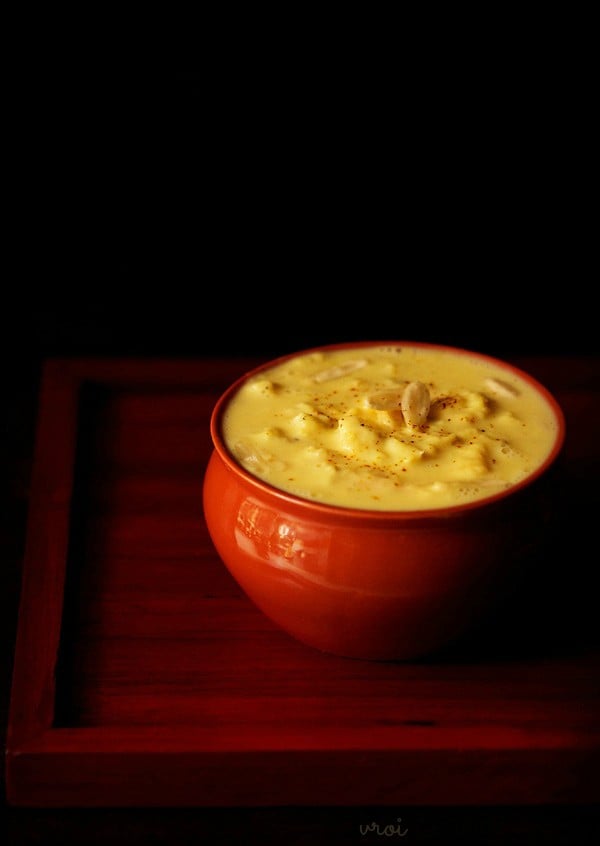
How to Make Rabdi Recipe
Blanch Nuts
Before you begin heating and simmering milk, I suggest to blanch the nuts and keep them ready. This blanching step is optional and you can simply sliver or chop the nuts.
Blanching nuts improve their texture and taste. To blanch the nuts follow the steps below.
1. Soak the almonds and pistachios in hot water for 20 to 30 minutes. Then remove the peels.
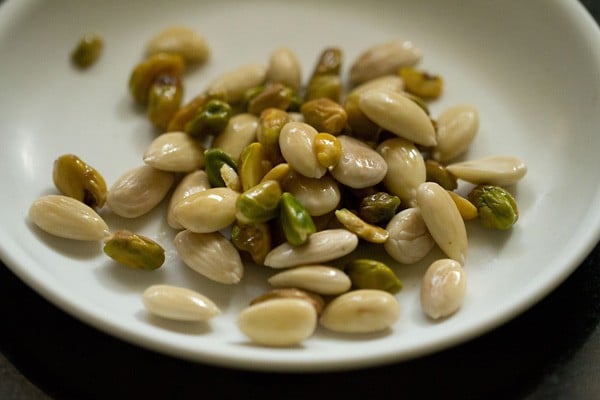
6. Slice, sliver or chop the nuts and set aside.
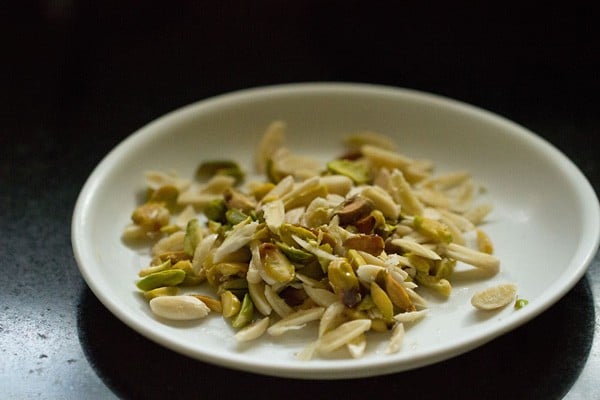
Cook to Reduce Milk
1. Add 1.25 litres of full fat whole milk in a kadai, and slowly heat the milk on a low to medium heat. Stir a few times when the milk gets heated.
The milk should slightly simmer but not boil. Once hot, the milk with start to froth or form a layer of cream (malai) on top.
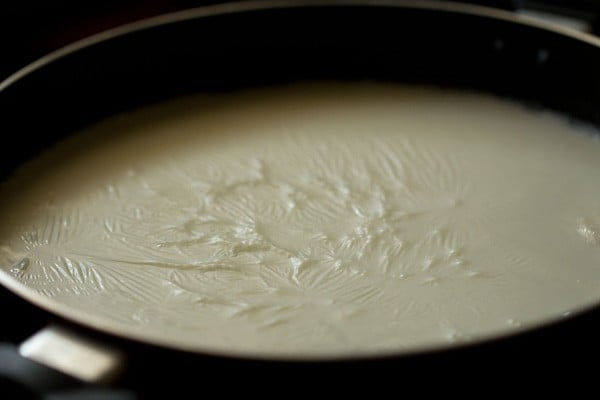
2. When you will see the cream floating on top, use a spatula to gently move the cream layer to the side of the pot.
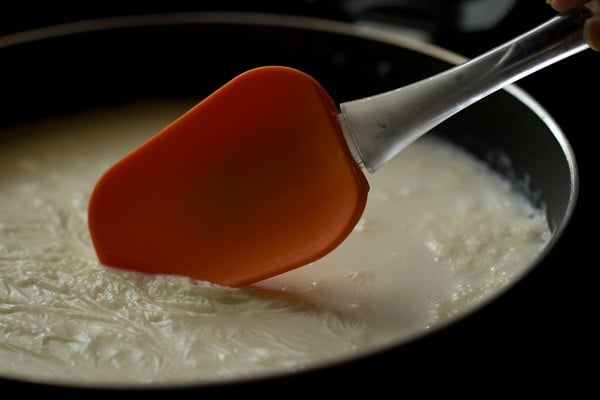
3. Stick the cream to the side of the pan.
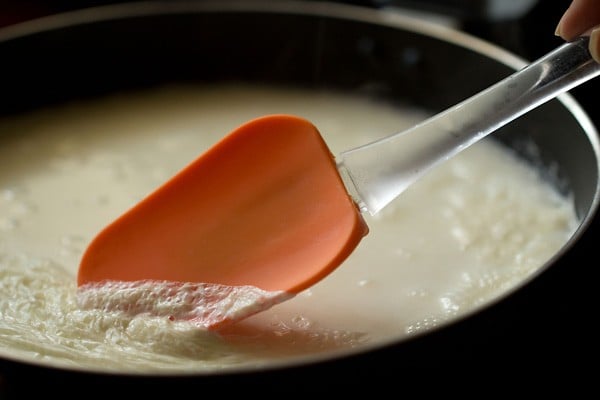
Collect Cream To Make Rabri
4. Continue simmering and stirring the milk on a low heat, collecting the cream layer on the sides, and sticking it to the pan.
You’ll be doing this for about an hour while the milk reduces, so be sure to keep a close eye on it so the milk doesn’t burn or stick to the bottom of the pan.
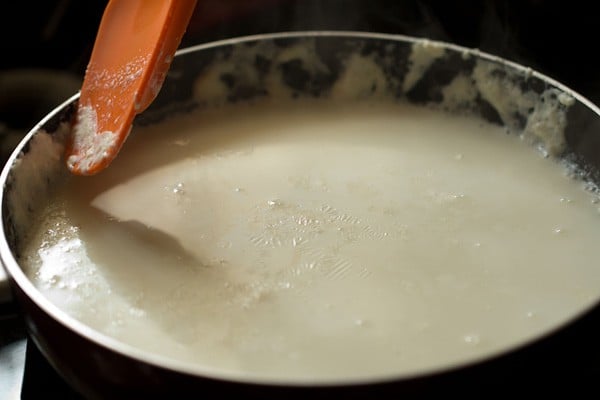
7. This process of collecting the cream has to be done many times. The finesse to making this rabri recipe is that you have to take care to find the right balance between leaving the milk alone so that the cream forms, but also stirring enough so that it doesn’t stick and burn on the bottom.
Keeping the above point in mind, stir the milk a few times after you have moved the layer of cream to the sides of the pan.
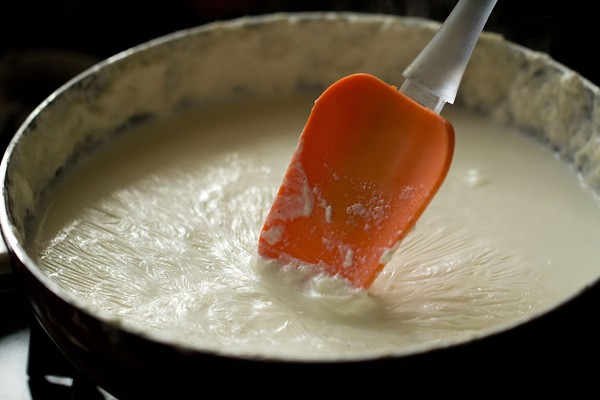
8. In this photo the milk has reduced to half about 30 minutes later. Notice that the layers of cream collected on the sides has thickened also.
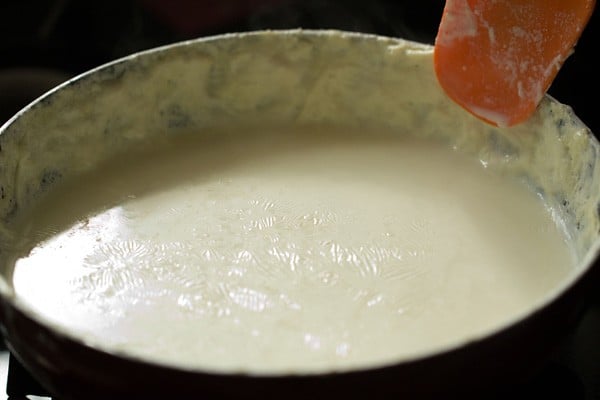
Make Rabdi Recipe
9. Once the milk has reduced to half, then add 2.5 to 3 tablespoons of sugar to taste.
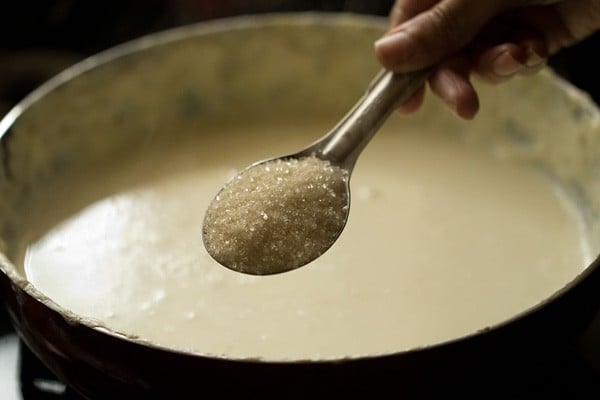
10. Then add a 15 to 18 strands of crushed saffron and ½ teaspoon cardamom powder. Stir gently.
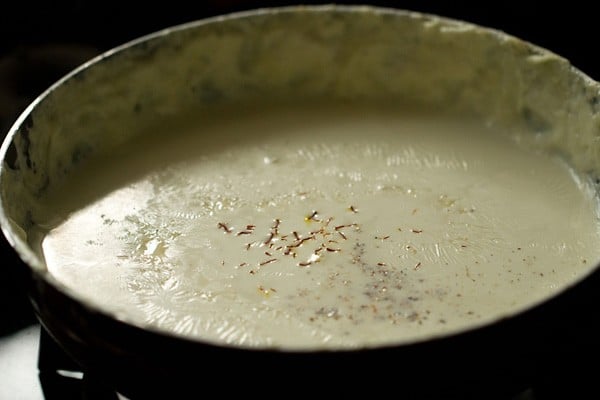
11. Continue to gently stir the milk and collect the cream on the side of the pan. The rabri will turn a lovely yellow shade once the saffron has been fully incorporated.
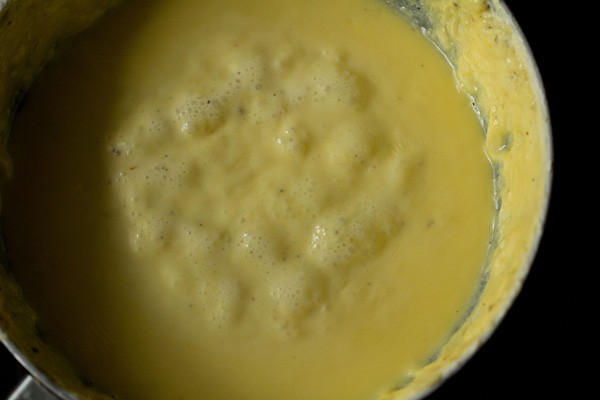
12. Now, in this photo, the milk has got reduced to ⅓ of its original quantity. This took roughly 1 hour 15 minutes.
Turn the heat off once the rabdi is the volume and consistency you like. You can also reduce milk to ¼ of its original volume.
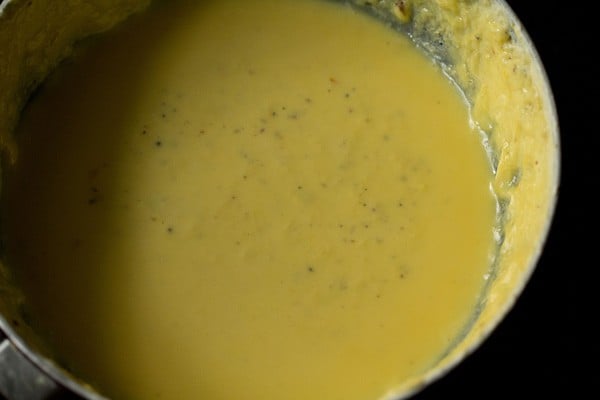
13. The cream layer will be collected on the sides.
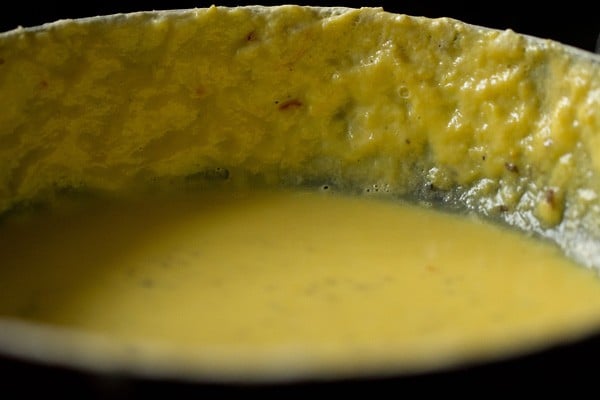
14. Scrape off the entire cream layer, as well as any dried milk solids with a spatula, and add back to the thickened milk.
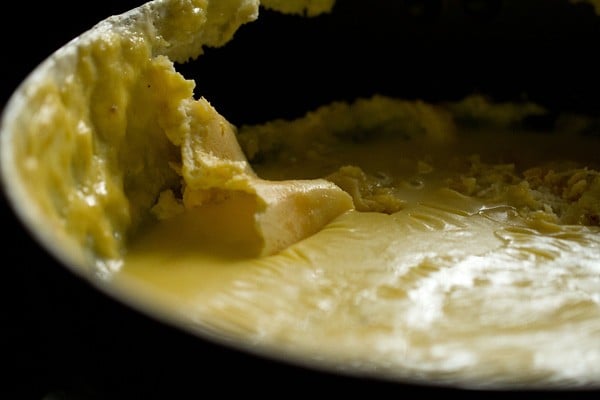
15. Stir gently.
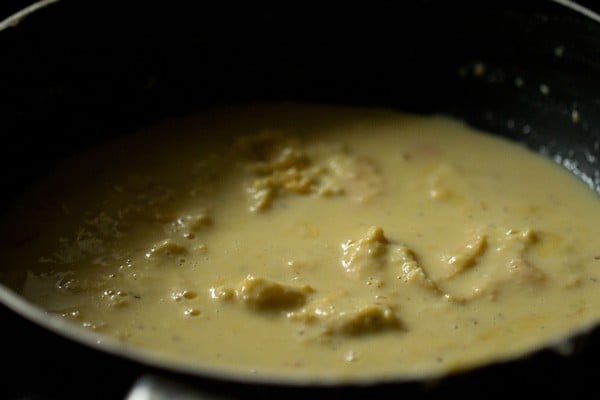
16. Now add the sliced almonds and pistachios, plus 1 teaspoon rose water or kewra water (pandanus water). Stir and mix gently again. Reserve a few of the blanched nuts for garnish.
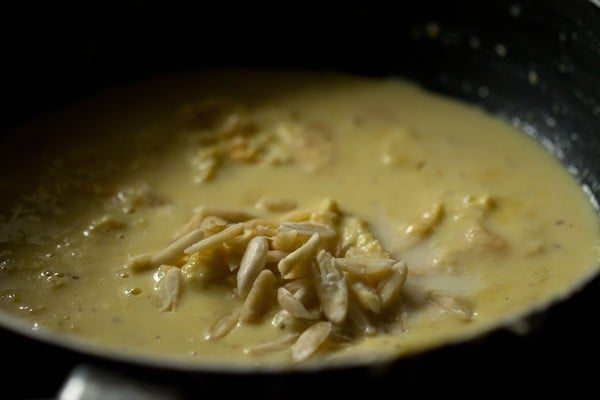
Serving and Storage Suggestions
Serve rabdi hot or warm or chilled. If not serving hot or warm, let rabdi cool at room temperature. Transfer the cooled rabdi in an air-tight steel container and refrigerate it for a few hours to cool.
Remember that it will thicken more as it cools at room temperature and even in the refrigerator. So keep the consistency slightly thin if you want to refrigerate it and serve cold.
Whether you serve hot or warm or cold, garnish with some of the blanched nuts and sprinkle a bit of crushed saffron if you like.
Rabdi keeps well in the refrigerator for 3 to 4 days. Store leftovers in an air-tight bowl or container in the fridge.
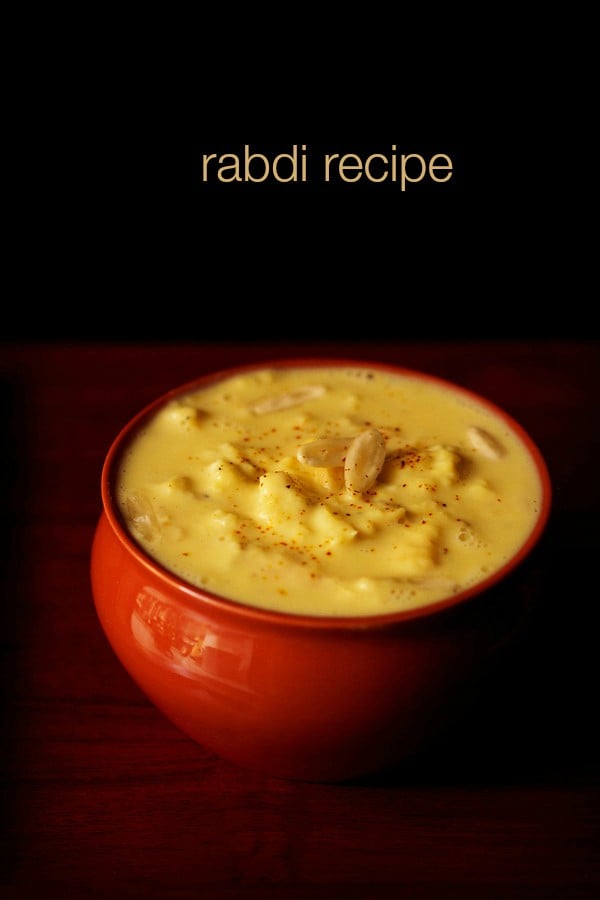
Expert Tips
- Milk: While making a creamy dish with layers of clotted cream a.k.a malai it is always best to use whole milk or full fat milk. Try not to make this sweet with low-fat milk or skimmed milk. You can consider using homogenized milk, but you won’t get thick layers of malai but thin layers and the rabdi will have a less creamy consistency.
- Pan type: As I have mentioned above when making recipes which require evaporation of liquids, always uses pans with a larger surface area. The larger surface area speeds up the evaporation process. You can use a non-stick kadai or steel kadai. But make sure that whichever pan or kadai you use, it should be heavy and have a thick bottom.
- Cooking: To make this dish the milk is simmered on a low heat. You do need to stir so that the milk does not burn at the bottom of the pan. But when you see the layer of malai or clotted cream forming then do not stir as you will break this layer. When the layer is seen and properly formed, then gently bring it to the side of the pan with a spatula. After that you can stir the milk a few times until you see the next layer of malai forming.
- Nuts and flavorings: Feel free to add nuts and flavorings that you have. You can add slivered or chopped almonds, cashews, pistachios and pine nuts. For flavorings, you can mix and match or add only one flavoring ingredient – cardamom powder, rose water, vanilla extract, kewra water (pandanus water) or saffron are some options
- To blanch nuts or not? While I prefer to blanch nuts when adding them to sweets, you can opt to skip the blanching step. Simply chop or sliver them and add to the rabdi when you add saffron.
- Scaling: This rabri recipe serves 3 as is. Scale it to make 6 servings or more. Remember if you scale up the recipe, it will take more time for the milk to condense, reduce and thicken.
FAQs
Low and slow is definitely the way to go here. If you stir too much or cook the milk too quickly, you won’t get those fantastic thick layers of cream in the dish.
You do have the option to just thicken and scrape the milk solids from the sides, like in this rabdi that I have shown in my Shahi Tukda recipe. Again, there won’t be the same layers but you’ll still have a delicious dessert!
There is a method of making instant rabdi with condensed milk. But it does not have an authentic taste or consistency like this traditional lachha rabdi recipe.
Traditional toppings for rabri include a bit more sliced almonds, pistachios, crushed saffron. You can also garnish with pine nuts or cashews.
I love to make Malpua to enjoy with rabri. It also is great to serve with other sweets like Gulab Jamun and Jalebi. Or simply pair with Falooda or enjoy with Poori!
Stored in a sealed container rabdi will last for up to 3 to 4 days in the refrigerator.
More Indian Sweets To Try!
Sweets Recipes
Sweets Recipes
Sweets Recipes
Sweets Recipes
Please be sure to rate the recipe in the recipe card or leave a comment below if you have made it. For more vegetarian inspirations, Sign Up for my emails or follow me on Instagram, Youtube, Facebook, Pinterest or Twitter.
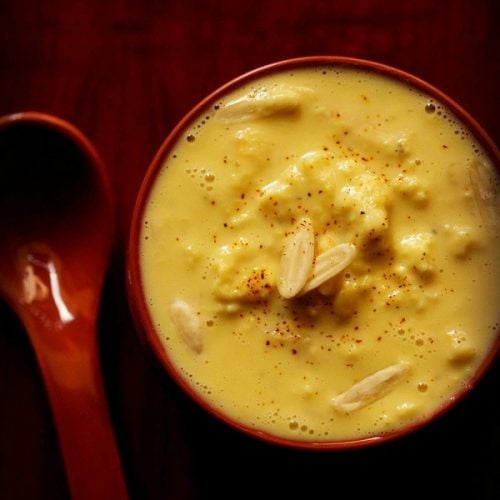
Rabdi Recipe | Rabri Recipe
Ingredients
- 1.25 litres whole milk
- 2.5 to 3 tablespoons sugar or add as required
- ½ teaspoon cardamom powder or 5 to 6 green cardamoms, crushed in mortar-pestle
- 12 to 15 saffron strands (kesar) – crushed
- 1 teaspoon rose water or kewra water (pandanus water)
- 2 tablespoons almonds (badam) – blanched and sliced
- 2 tablespoons pistachios (pista) – blanched and sliced
Instructions
Prep nuts
- Soak almonds and pistachios in hot water for 20 to 30 minutes. Drain the water. Then remove the peels from the nuts.
- Slice or sliver or chop them and set aside.
Cooking milk to half of its volume
- Take whole milk in a thick bottomed kadai or pan and begun to heat the milk on a low to medium heat, till the milk starts to froth or form a layer of clotted cream (malai) on top. Stir a couple of time when the milk is getting heated.
- So when you will see the cream floating on top, then with a spatula, gently move the cream layer.
- Bring it towards the side of the pan and stick it to the pan. Keep the heat to a low and continue to simmer.
- Keep on simmering the milk like this and collecting the cream layer on the sides.
- This process of collecting the cream layer has to be done many times. continuous simmering of the milk will bring the cream on top and you have to bring and stick it to the sides of the pan.
- In between also stir the milk gently on occasions, so that the milk does not get burnt from the bottom. If you do too much of stirring and if quickly, then you won't get the layers of cream in the rabri.
- So after you have moved the layer of cream (malai) to the side of the pan, then stir the milk a few times. Then wait until another layer of cream forms on the surface of the milk.
- You can also just thicken and scrape the milk solids from the sides but in this case you won't get the layers of clotted cream or malai in the rabdi.
Making rabdi recipe
- Once the milk reduces to half, then add sugar. You can add sugar as per your taste preferences.
- Then add crushed saffron strands and cardamom powder. Stir gently.
- Continue collecting the cream and bringing it to the sides of the pan. Also do stir the milk gently after you bring the cream towards the sides of the pan. If you don’t stir the milk then there is a possibility of the milk getting browned or burnt from the bottom.
- After adding saffron, the color will change gradually to a beautiful yellow color as the milk keeps on reducing.
- When the milk gets reduced to ⅓ or ¼ of its original quantity, then switch off the heat. It took me about 1 hour 15 minutes on a low heat initially and medium heat towards the latter stage. I cooked it until ⅓ of its original volume.
- The cream layer will be collected on the sides with a spatula. Scrape off the entire cream layer as well as dried milk solids and add into the thickened milk.
- Stir gently. Then add the sliced almonds, pistachios and 1 teaspoon rose water or kewra water. Stir gently again. Reserve a few of the blanched and slivered nuts for garnish
Serving and Storage Suggestions
- Garnish with some of the blanched almond and pistachio slivers. Serve rabdi hot or warm.
- If you are not serving hot or warm, let rabri cool at room temperature first. Transfer the cooled rabdi in an air-tight steel container and refrigerate it for a few hours.
- Keep in mind that it will thicken more as it cools at room temperature and even in the refrigerator. So keep the consistency slightly thin if you want to refrigerate it and serve cold or chilled.
- Whether you serve hot or warm or cold, if you prefer, garnish rabdi with some of the blanched, slivered nuts and sprinkle a bit of crushed saffron from top.
- Rabdi keeps well in the refrigerator for about 3 to 4 days. Store any leftover in an air-tight container or bowl in the fridge.
Notes
- Pan: Use a pan having a larger surface area as it helps in the evaporation process and speeds it up. A kadai or wok is the best pan that you can use as they have a larger surface area. Also keep in mind that the pan should be heavy or have a thick bottom so that the milk does not burn while cooking.
- Milk: Use whole milk or full fat milk. Don’t make this sweet with low-fat milk or skimmed milk.
- Cooking: You have to slow simmer milk on a low heat to ensure that it does not brown or burn at the bottom. You do need to stir so that the milk does not burn at the bottom of the pan. But when you see the layer of malai or clotted cream forming on the top of the milk, then do not stir. Stirring will break this layer. When the layer is properly formed, then gently bring it to the side of the pan with a spatula. After that you can stir the milk a few times until you see the next layer of malai forming.
- Nuts and flavorings: Feel free to add nuts and flavorings that you have. You can add slivered or chopped almonds, cashews, pistachios and pine nuts. For flavorings, you can mix and match or add only one flavoring ingredient. The options are cardamom powder, rose water, vanilla extract, kewra water (pandanus water) or saffron.
- Blanching nuts: You can choose to skip blanching the nuts. Simply slice or sliver them and add to the rabdi when you add saffron.
- Scaling: As is this recipe serves 3. You can scale it to make 6 servings or more. Remember if you scale up the recipe, it will take more time for the milk to thicken and condense.
Nutrition Info (Approximate Values)
This Rabdi recipe from the archives, first published in Jan 2015 has been republished and updated on October 2021.
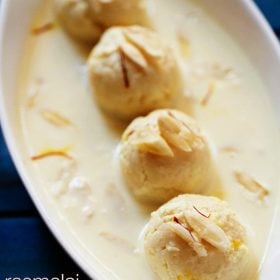
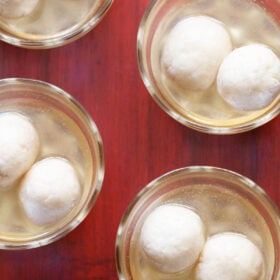
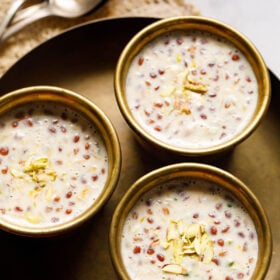
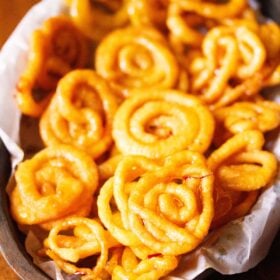
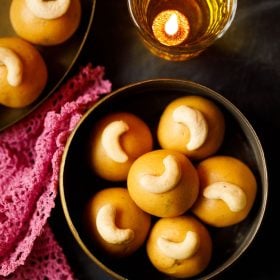
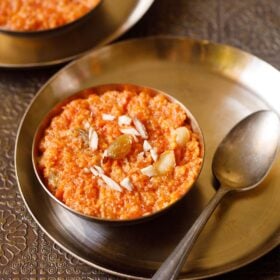
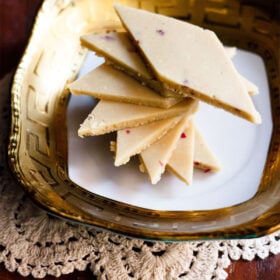








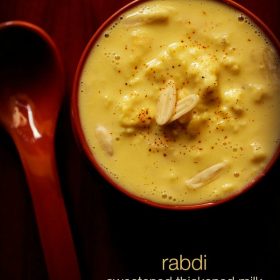
looks delicious, haven’t tasted before, i would love to give it a try !!
Do try and I hope you will like it.
Very yummy
Hi Dassana,
Im a big fan of you. Im an amateur cook most of the times or rather all the time i refer to your recipes before i start cooking for my family. My kids love all the dish that i make specially the one followed from your site. My son’s birthday is upcoming and i want to try to make Rabri. I wanted to know if i can use condensed milk to get the thickness or the creaminess. If so could me please suggest how to make it.
Thank you Gayathri for the lovely feedback. For the rabri you can take 3.5 to 4 cups of milk and boil it first. Then add ½ cup sweetened condensed milk and cook till the mixture thickens. If the rabri tastes too sweet, then you can add some more milk. if it less sweet, then add a few tablespoons of condensed milk. Add the saffron which has been mixed with some warm milk, nuts and dry fruits. You can add the saffron when adding the condensed milk too. Happy cooking.
Was so yummy.
Hi Dassana,
Thank you for the recipe. It looks delicious.
I want to try it but we dont get organic milk here and the full fat milk also does not cream up much. I was wondering if I should add a can or two of evaporated milk to it. Please advise.
Thanks
welcome neha. you can add some evaporated milk to thicken and it will work.
Thanks for the yummy recipe.
Can we make rabri with heavy whipping cream?
rabri cannot be made with whipping cream. welcome.
Thanks so much
welcome tulika
Lovely Recipe, everyone enjoyed it including kids. We stopped having it from market now. i have become Rabri specialist at home. thanks so much for the recipe.
welcome shilpi and so glad to read your comment. thanks for the feedback on rabri recipe. happy cooking.
Yummy and easy.made this today yo go with your jalebi recipe. Have to stop myself from eating too much.
thank you dinah for sharing the feedback and the rating. yes jalebi and rabri is an irresistible combo. happy cooking.
Thanks…I will definitely try this one …
sure sheetal, do try.
Hi,
I made the rasgullas from recipe from another site. They did not hold well, so I went to your site to use those rasgullas in making the rasmilai which turned out really really great.
I have a question about the milk that is used for rabri. I live in Canada and the homo milk has 3.25% fat. This milk does not form layers of cream like I saw on this recipe.
What is the fat % of the milk that you are using for this recipe.
Thank you so much. I love your website and I am here to stay.
Please respond as soon as you can.
Welcome Tina. I have used full fat milk. it is 100 percent fat.
Hi Dasanna! Love your recipes! Truly mouth watering!
Well, I have a very strange question.
Can we use more quantity of toned milk instead of full fat whole milk?
jayasri, you will need to give a try. usually for rabri, full fat milk is the best. but i think it should work. adjust the amount of sugar, dry fruits, saffron as required.
Thanks for your reply!
May I know which brand milk did you use? Here Amul Taaza and Nestle A+ are available.
welcome jayasri. i used organic milk for this recipe. you can use amul gold.
while making rabdi milk spoiled what can be done with the milk?
sandhya, strain the milk and then you will get rich chenna. just mash the chenna or grind with sugar in mixie. then make sandesh. or you can cook the ground chenna lightly and then make sandesh. or you can let the entire water evaporate. add sugar. and make a paneer like sweet.
My rabdi got a bit of sour taste. what would be the reason
rabdi getting a sour taste is due to using milk which is one the verge of getting spoiled or a bit spoiled. hope this helps.
ok … thanks
I m a new cook…. and vegreceipes is the guide for me ….
Helping me to experiment new receipes as i get bored eating the same food again n again.
pleased to know that thankyou sandhya 🙂
very nice sweet …
I made the rabri for the very first time and it tastes divine. Will make the malpua tomorrow for holi. Thanks a ton yet again dasana.
pleased to know this thankyou so much sridevi for your kind and honest words 🙂 wish youa dn your family a happy holi.
I had made rasmalai earlier too with the traditional method of rabri. This time I want to make it again but I am confused about which will taste better rasmalai with condensed milk or the traditional method. Please help me out.
Waiting for your response.
kaur, the traditional recipe is better. with condensed milk, i always find the rasmalai to be more sweet and plus one does not get the malai wala texture of rabri in condensed milk. if short of time, then you can use condensed milk.
Thank you . I will make it again soon.
sure harsimrat 🙂
First time a receipe as detail as programming a computer 🙂 along with photographs
thank you krishna.
Hi dassana I am chef I am working in Australia I was looking for the rabri recipe that one is awesome frankly speaking I am more western style chef then indian style and this rabri recipe really goes good with ghulab jamun .i am not so good in indian desserts but this recipe simple and delicious I got heaps of compliment for my indian theam night . Thanks for sharing your recipes .
pleased to know this bobby and thankyou for your kind words. glad your team liked the rabri recipe 🙂 you are always welcome.
Madem..I REALLY THANKS TO U FORGIVING ME THE RECIPE OF MY BE SWEET FAVORATE DISH. I LIKE.I AM FROM HYDERABAD& I REALLY THANKS TO U VERY MUCH……
thankyou dr mirbaqtiyarili :)and you are always welcome.
Hi, love ur culinary skills. I have a question – what is the difference if you add sugar while making the dish as you have explained or prepare condensed milk and then add while preparing? Also I love to steam the condensed milk further for brownish colour in rabri. You have added saffron some time later after collecting some white layers of milk. Any specific reason or you can add it at the beginning too???
thanks. sugar can be added first too. but i add sugar later as the amount can go awry if added first, since the milk keeps on reducing and getting thickened. thus the concentration of sugar increases. since in the recipe i have already mentioned the amount of sugar, you can add it first too. but when making without measurements, its better to add sugar later. saffron has a delicate aroma and if cooked too much, the freshness of its aroma reduces. ideally it should be added at the last stage. but to get a bright yellow color i have added it in between.
Thanks for the tip. Actually I was asking for adding condensed milk in place of sugar. I would like to know the difference in cooking with sugar like you did or by adding condensed milk. Also comment which is better style of cooking.
fine. i thought you are referring to rabri as condensed milk. since the milk is getting condensed in a way. with condensed milk the taste will be different than with sugar. in fact the rabri will me more richer with condensed milk. with condensed milk the time would also reduce. i would suggest to make the rabri with sugar as that gives the authentic taste. but then its totally upto you and what suits you 🙂
Thanks. The tips are really precise and helpful…
welcome and thankyou karan 🙂
Love your blog! Your recipes always turn our delicious no matter what; even when I make minor modifications to suit our taste or availability of ingredients. 100% success, every single time!
we are glad to know this thankyou for your encouraging and kind words 🙂
Heya dassana, I tried this rabadi recipe today with few of my variations and I must say that it turned out so well that I am in awe..I am so thankful to u for sharing ur wonderful recipes with us. I have added little condensed milk and crumbled paneer to speed up the process and to achieve thickness as here in england it’s really difficult to get full fat milk. Thanks again ur truly wonderful.
thankyou abhiruchi for your kind words 🙂 pleased to know you liked the rabri with your modifications. you are always welcome.
Hi dassana,
I must say, this is my favorite cooking blog. The elaborate cooking steps and the tips in between, and those amazing pictures. I keep coming back again and again everytime trying something new from your blog. Thank you so much 🙂 Looking forward to many more recipes from your blog… 🙂
Regards,
we are quite glad to know this janhavi 🙂 do keep coming and keep sharing your views would love to hear from you. you are always welcome and thankyou so much for your kind words.
I have tried this recipe……
Very Yummy and delicious and awesome.
thanks megha
Awesome & in a very simple way u explained us…. thanq ?
welcome sutapa
Hi, first I was introduced to this website through Facebook from my friend. From that day I have become your fan. Is rabdi and basundi are same
thanks sushma. rabdi is more thick than basundi. though the preparation is same, for rabdi the milk is simmered further than what is done for basundi.
Thanks for sharing such a good recipy. I really appreciated ur efforts
welcome anees
Dear Sir i really thanks to u for giving me the receipe of my be sweet dish i like i am from pakistan and i really thanks to u very much
welcome sarfraz.
Hi Dassana,
I tried this recipe last weekend. It turned out really nice and yummy. My husband loved it and so did I. I never knew making Rabdi was so easy, it is one of my most favorite sweet.
Thank you so much, I love your blog!
welcome harsha. glad to know this. thanks for sharing positive review on rabri.
Hi dassana, I made the above recipe . took me 1 and1/2 hr . . turned out so nice that my 8 yr old son wants me to make it again. He just loved it. Never I thought I would make rabri at home. Thanks to you.
welcome marina. glad to know this. thanks for sharing positive review on rabri.
Today is my Papa’s birthday and he don’t like cakes etc. So while he was away at work, i came on your awesome blog(its my google for cooking) and found this. I made it and it came out unexpectdly well for a beginner in cooking like me.
Thank You Di.. you explain it so well ^_^ 😀
welcome neha. thats really good to know. i appreciate you cooking for your father. do try some more recipes. as knowing little cooking helps in long run.
This has turned out to be just yummylicious. My 8 year old was a little skeptical to have it but once he tasted just a tiny bit and he is all over this rabri. Thanks for sharing it. Would be trying a few more recipes from here. 🙂 🙂
welcome kukum. glad to read your positive feedback. loved reading about your kid response.
Wow..m just having this rabri..
The recipe is very easy and yummy
thanks parul for sharing positive review on recipe.
Hi Dassana,
I really want to thank you from the bottom of my heart. I have never been interested in cooking for so many years and now that I am alone in Berlin, my only life support are your blogs. I live on them literally. I like to try all new recipes and I think I am better at cooking than being an engineer 😉 My family is surprised when I send them pictures of what I have cooked. My fiance seems to be too happy although her reasons of being happy are mean 😛
Your pictures, your writing style, your explanations- Everything is simply the best I have come across.
Thank you so much Dassana. You have made my life so easy and interesting. AND (YOU) have made me a good cook (according to my peers).
This Rabri recipe is on my list for the coming weekend.
God bless you in abundance.
welcome mahesh. thats very good to know. its like blessing in disguise as you are staying alone. good to know that you are learning cooking and getting admiration from friends. thanks for your encouraging feedback and blessings. all the best.
Dear Dassana,
This page is a “WORK OF ART”
thanks a lot, suman. i am happy to read your appreciating words.
Wahhhhh….I basically dislike sweets….but the pictures of your post inspired me to cook this….though it was a tedious process the end product was heavenly….too much applause at home….again….all kudos to you….:) 🙂
thanks priya for this sweet feedback. glad to know that the photography inspired you to try rabri. the process is long but if you do something else in the kitchen then you will not feel that its a long process. i usually cook my lunch and rabri side by side. so the time does not register.
This process of making rabri is amazing and I love this dish too much